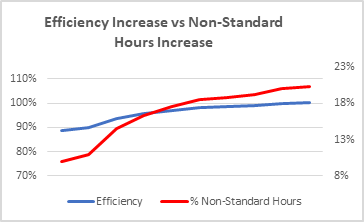-png.png?width=520&name=5%20Tips%20to%20Save%20-%20Week%205%20Header%20-%20Reduce%20Non%20Standard%20Hours%20(1)-png.png)
When prioritizing labor, commercial laundries need to understand the relationship between non-standard hours and their bottom line. It is a delicate balance that can be tricky to navigate alone. With Spindle, however, everything you need to know about your plant’s non-standard hour allocation is right at your fingertips.
Non-standard hours are hours allocated to tasks without a target. These hours play an essential role in the laundry industry, yet many operators fall short in measuring and setting clear goals when it comes to the amount of time they should be spending on these tasks.
We have found the best-in-class laundries share a goal of limiting non-standard hours to be less than 10% of all hours. Before diving into how they can accomplish this, let us take a step back and talk about why measuring non-standard is important in the first place.
Why are non-standard hours important to the bottom line?
Take, for example, an industrial commercial laundry that has a weight per operator hour (WPOH) of 100, a total of 2,000 labor hours a month, and 10% (200) of these hours were spent in non-standard time. In January of 2021, the plant had an efficiency of 89%. As the team’s productivity rose, they noticed their WPOH remained constant at 100. How can that be?

It turns out, as their efficiency rose from 89% to 100%, their non-standard time rose from 10% to 20% as well. As the team began finishing their work more quickly (due to the increase in efficiency), they logged into these non-standard tasks so their efficiency is would not be affected negatively.
To reduce labor cost, you must either reduce labor hours or increase volume.
To reduce labor cost, you must either reduce labor hours or increase volume (without increasing labor hours). While production efficiency is a very important indicator of your team’s success, monitoring these non-standards hours is equally as important.
How do you manage these non-standard hours?
In order to manage your non-standard hours effectively, you need to have accurate and timely data. At Spindle, we automatically collect data from around your plant and display it in real-time. When your plant’s non-standard time exceeds a specific threshold, Spindle will alert your supervisors and managers alike, allowing your team to determine if that task is necessary and take immediate action in resolving the issue.

Accurate, immediately available data is a steppingstone to begin implementing procedures that ultimately lowers labor costs across the board. By monitoring and limiting the non-standard working hours in your plant to be below 10% of all hours, your team is on it’s way to improving the bottom line.

-png.png)
-png.png)